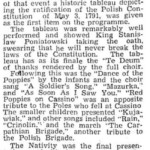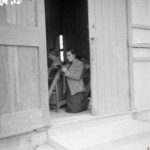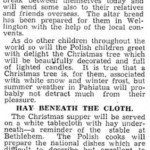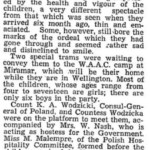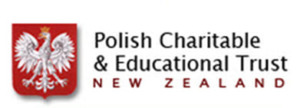Polish Refugees in New Zealand 1944-1951
Exhibitions
Church and Festivals
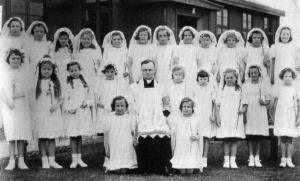
First Holy Communion – Pahiatua 1947. Back (l-p): Leokadia Jackowska, Irena Frydrych, Danuta Szysz, Barbara Sprusińska, Ewa Wierzbicka, Stefania Kamińska, Stanisława Markowska, Wanda Szczawińska, Aleksandra Wawryka, Barbara Szczepańska, Alicja Głowacka, Irena Okołów Front (l-r): Antonina Wołyncewicz, Halina Sawlewicz, Alicja Wiśniewska, Helena Characzko, Father Michał Wilniewczyc, Emilia Sordel, Zofia Markowska, Urszula Bednarska, Halina Wenckiewicz, Bronisława Jasionowicz Kneeling (l-p) Olga Sajewicz, Alfreda Kornobis. Source: Polish Children’s Reunion Committee 2004
Dr Andrzej Chibowski: Boys at the camp liked to serve at the altar and considered it a great privilege. Antoni Leparowski wrote:
“Attendance at Sunday Mass was compulsory, but though attendance at daily Masses in the chapel was voluntary, they were very popular. If you were late, you had to stand or kneel outside for lack of space. But we would do anything for our beloved Fr Michaś. Boys flocked to serve at Mass. It was an honour to have been chosen, because there was a long waiting list. A boy had to learn Latin responses to become an altar server, as this was required for the Latin Mass. I managed to serve a few times.”
Fr Michał was a perfectionist and demanded the same from the altar servers. Stanisław Manterys says: “I was one of his altar servers. He did not tolerate shoddy attitudes and would reprimand any boy who did, but the severe frowns and hard words were short lived and his kindness soon returned.” Danuta Juraszek: “I remember him very well. I attended Mass every day. He was surrounded by respect and was loved by the children.” Czesława Panek-Wierzbińska: “He was very popular. He celebrated daily Mass in the chapel, which was built especially for us and which seated about 50 people. It was still being completed when we arrived at the camp.
On Fr Michał’s initiative, a grotto was erected near the camp’s boundary, dedicated to Our Lady of Lourdes. It was built of stones carried from the nearby river by the children. After the official dedication, which was attended by Fr Cashman, parish priest in Pahiatua, the grotto was constantly in attendance with children singing hymns to Our Lady.
In June he held expositions of the Blessed Sacrament with sung prayers for the deliverance of the Polish nation from its catastrophic situation. Some of the prayers he had composed while in prison. He emphasised the great importance of faith in people’s lives. The children recognised this and their prayers for a better future were heartfelt and frequent. Each day started and ended with prayers of thanks for deliverance and pleas for their lost families. The prayers were often spontaneous, arising from an internal pain of the soul.
He celebrated his first Mass the day after arrival at the Pahiatua camp, on All Souls Day, with prayers for the dead, especially those who did not survive the exile in Russia or the war and who lay buried in Siberia, mostly in unmarked graves, or in Iran. That evening Fr Michał led the residents in the recitation of the Rosary in thanksgiving for the safe arrival in New Zealand. Many went to confession.
5 November 1944 was the first Sunday at the camp and began with a solemn celebratory Mass for all the residents, which began a new period in the orphaned children’s wandering lives. Children and young people gathered with their teachers, supervisors, the camp commandant and Countess Wodzicka and listened carefully to the words of a sermon by Fr Michał, which began with:
“Holy God, Holy Mighty and Holy Immortal One, have mercy on us. Beloved youth, dear countrymen! We begin life in a new place surrounded by the exceptionally warm hospitality of New Zealand. We are entering a new episode during our wanderings in exile. It is not the first one on our journey filled with thorns. We were brutally taken from our occupied homeland, into a land of terror which became filled with our suffering. We left our dead in graves marked only with simple crosses and trudged over roads smeared with our blood and tears. But among all our sufferings, our Saviour, Jesus Christ, stood out like a beacon. He was your unseen and constant companion in the long journey which you were forced to take during your short life.”
His sermons to the children were full of encouragement to not forget the moral, religious and patriotic values inherited from their parents. He reminded them of Poland’s glorious past. He told them that they are their shattered homeland’s representatives on foreign soil, so far away from the homeland. He was concerned that these children may be lost to Poland, which had already lost millions of its people and could not afford to lose more. He prayed for the Polish people in New Zealand to live in love and unity. He strongly believed in the power of prayer, which he tried to instil in the children.
A few days after the arrival in the camp, Fr Michał officiated at Poland’s national day Mass. This was also his fifth anniversary of imprisonment by the Russian secret police. Poland’s fate was constantly on his mind, which he compared to Christ’s suffering on the Cross on Good Friday – the invasion of Poland on 1 September 1939 was also on a Friday. His sermons made a big impression on his listeners. It moved their hearts and impressed itself in their memory.
Fr Michał was very diligent in his priestly duties. He celebrated daily Masses and evening devotions on the numerous special days in the Church’s calendar. He prepared the children for the Sacraments. There were more than a dozen children at the camp who were complete orphans and had no brothers or sisters nor any evidence of having been baptised – they did not even know their surnames or where and when they were born. Fr Michał gave them provisional baptisms so that they could go with the other children to their first confession and communion, which for the children was a deep experience.
At their first communion the children looked beautiful in their new white clothes, sewn with funds collected by the camp’s Polish administration. Each had mementos of this event – a prayer book and holy medal. Fr Michał wrote:
“I led them to the front rows before the altar in the main hall. The choir sang the hymn Veni Creator Spiritus, after which the camp’s headmistress, Janina Żerebecka, led the children in the renewal of their baptismal vows, as formulated by Pope Pius X. They carried the communion bread and wine and candles to the altar, which was beautifully decorated by Sister Monika Alexandrowicz, creating a prayerful atmosphere.
“Jesus carried you in his arms during the long road of your exile. You will now carry Him in your heart and go with Him on the road to your heavenly homeland.”
After the Mass the children were treated to a festive breakfast prepared for them by the adults. Later the older children were prepared for the sacrament of confirmation. Archbishop O’Shea, the head of the Catholic Church in New Zealand, arrived to take part in this special event. After a formal welcome by the children, he was led to the main hall under a portable canopy, where he addressed the youth gathered there (through an interpreter). 119 boys and girls were confirmed that day. Because this happened during the Christmas period, the young people sang traditional carols. They also performed the traditional Christmas play Jasełka (crib).
Two of the confirmed children presented the archbishop with a hand-embroidered napkin and a plate with Polish national symbols. Fr Michał wrote:
“We tried to welcome him with due ceremony and according to Polish traditions. This was unusual in New Zealand where a bishop visits his parishes as a private person.”
All the Polish religious services were celebrated with commitment to the Polish tradition. On those occasions the main hall was always full. The children and the adults, having been sorely tested by fate, held strongly to their beliefs. The rich traditions of Polish Easter and Christmas became permanent fixtures in the camp.
The first Christmas at the camp, only two months after arrival, was celebrated by the Poles with great intensity and a will to maintain its Polish character. During the four weeks before Christmas, Fr Michał celebrated the traditional Polish daily dawn Mass of the Advent period (“Roraty” in Polish). In the second half of December he started hearing confessions. Listening to hundreds of confessions was hard and demanding work. Living in a camp environment, each child and young person needed deep spiritual guidance. At the Christmas Eve supper, he broke and shared the traditional wafer (opłatek) with the children, together with the seasonal greetings. The children sang the traditional Polish Christmas carols and received gifts. Fr Michał wrote:
“Christmas Day here is in summer. In my address to the faithful I expressed the wish that our beloved homeland, mired in darkness and shackled in slavery, could experience the light of freedom shining from Bethlehem, that it could hear the voice of angels announcing independence, for our country to become a manger of Christ’s teaching, that heaven be filled with joy at our deep faith and our love for God and the homeland.”
The Christmas festivities of the following year in 1945, the second in the camp, were considerably dampened by the shattering news early that year about the result of a conference held at Yalta in the Crimea, where the three allied powers, represented by Stalin of Russia, Roosevelt of the United States and Churchill of Britain, agreed to a division of Europe. Poland lost its eastern territories to Russia and the truncated nation was to become its satellite. It was to be governed by Communists appointed from Moscow. The mood at the camp that Christmas was depressing. Everyone gathered at the Midnight Mass, during which more than 400 people received Holy Communion. Christmas Day, 25 December 1945, the Feast among feasts, but celebrations were muted. The thoughts of the adults and children were with their homeland. Many remembered the first snowflakes, the smell of a Polish Christmas tree, the festive family atmosphere. Fr Michał records in his diary:
“Here it rained on Christmas day. Nature is sad. One did not feel like celebrating. Everyone stays indoors, only a few go out to visit. We feel abandoned by everyone, thrown into the maws of bloodthirsty Russia. How hard it is – oh God, how sad! We await the Star of Bethlehem to lead us to a free Poland.”
Easter at the camp – the Resurrection – was celebrated as the most important holiday of the year. It is preceded by Lent, the four-week period of fasting which starts with Ash Wednesday. During that time “Gorzkie Żale” (bitter sorrows), the traditional prayers of sorrow, were sung commemorating the suffering and death of Christ before his resurrection. (The traditional Polish devotion during Lent originated in the early 18th Century in the Holy Cross Church in Warsaw, Poland. It was primarily a collection of popular songs and melodies used by people in villages around Warsaw to reflect on the Passion of Christ.) Other religious observances during the period included the Stations of the Cross. Fr Michał also held retreats for the older children and adults, in preparation for the proper celebration of Easter. Fr Michał wrote:
“The blessing of palms on Palm Sunday, reading the scriptures about Christ’s suffering, Mass commemorating the establishment of the Eucharist, the adoration of Christ’s tomb with the Scouts keeping a nightly watch, Stations of the Cross, blessing of fire on Easter Saturday – all this reminded me of my first years of priesthood in my homeland and later the Masses celebrated by me in secrecy in the Siberian forced-labour camp.”
Easter Sunday Mass was celebrated with special ceremony, with a procession along the camp’s streets, traditional hymns of joy, a decorated Cross leading the people, altar servers carrying candles, the preschool children dressed in Polish regional costumes carrying icons and throwing flowers before the priest, who held a monstrance embossed with the Polish White Eagle carrying the white Host, accompanied by four older boys who carried a canopy over his head – all this presented a picture of a Polish Easter.
But for Fr Michał all this Polish ceremonial held on New Zealand soil was only a shadow of the real thing. He wrote:
“I do not feel the mood of Easter. How very different it was in Poland. Here – as some people say – only the liturgical celebrations remind us that we are celebrating a great feast. Life here is so grey and monotonous that the people have to remind themselves with effort that this is a Polish Easter. The special Easter meal in the camp was a pale imitation of the traditional Polish Easter plate of painted eggs, fresh homemade bread and aromatic smoked sausage.”
The feast of Corpus Christi (Body of Christ) is celebrated 60 days after Easter on a Thursday and is a public holiday in Poland (even during Communist rule). The Polish orphans and their teachers deeply experienced the solemn procession on that important day attended by all residents at the camp. A white altar on a high podium was erected in the main hall and decorated with flowers. A crucifix stood on the altar and below it a copy of Leonardo da Vinci’s “Last Supper”. After Mass, Fr M Cashman, the invited parish priest from Pahiatua, took the golden monstrance containing the Host and bore it in procession under a canopy carried by four boys between four altars erected around the hall. The youngest girls walked in front dressed in white, with flowers in their hair, some in colourful regional costumes. They paused at intervals to turn and bow before the Host, and then said a little prayer and cast flowers before the procession.
The procession was led by older boys carrying banners symbolising some spiritual theme. Next came older girls from the Marian Guild movement, followed by the Scouts. Following the Gospel sung in front of the altar dedicated to the Sacred Heart of Jesus, the procession went to the Grotto erected from river stones on the outskirts of the camp and dedicated to the Blessed Virgin Mary of Lourdes. The third Gospel was sung before the altar, which symbolised the Polish homeland: “Amid the national colours, a large-sized White Eagle spread its wings. Its chest was adorned with the icon of Our Lady of Częstochowa, which has a special place in the Polish nation.” The fourth and last altar was decorated with an intricately woven carpet hung above it, depicting the crucified Christ, source of strength and life.
One of the Polish children, Bronisław Rożniatowski, remembers that day well: “There was a downpour during the Mass and we prayed for it to stop before the procession. The rain stopped in time. I heard one of the New Zealand women saying: these people have a deep faith in God because the rain stops for them.” The invited New Zealanders saw such a procession for the first time. Everything had to be explained to them because it was unknown in this country.
A religious ceremony which impressed the New Zealanders was the feast of Christ’s ascension into heaven, which fell on 30 May that year (1946). At the request of the New Zealand Church authorities, Fr Michał performed an act of dedication of the Pahiatua Camp to the Immaculate Heart of Mary. During the month of May he familiarised the “little Poles” with the famous apparitions of Mary in Fatima in 1917. He dedicated the orphan children to the care of the Mother of God. This was fitting because the children needed a mother’s care after the loss of their mothers during the time of terror and hunger in Siberia.
Fr Michał’s mother had dedicated him to Mary, the Mother of God, who was a constant presence in his life. His unfailing moral strength came from constant prayer starting from his early years, in the seminary, then in his prison cell and during the difficult years in exile. He tried to instil that love of Christ and Mary into his young charges in distant New Zealand. A note from his diary:
“Today, nations bow before golden idols of self interest and wealth. They have abandoned morality, justice, ordinary human integrity and their consciences. It seems that the world, so much more populous than in the time of Christ, has given its allegiance to a bloodthirsty beast, such as described in St John’s Apocalypse, full with filth and the blood of innocent people, saints and martyrs.”
Fr Michał took his priestly duties seriously by observing as many as possible of Poland’s colourful and numerous religious feast days and ceremonies, in which the camp’s inhabitants willingly participated, which enriched the life of the camp and which was a measure of his popularity. One of the unusual and touching ceremonies was the acceptance of an icon of Our Lady donated by two New Zealanders, Sylvia Wilson and Sylvia Chapman. It was a copy of a bas-relief carved in secret on a piece wood by a Polish soldier in the Russian prison of Kozielsk in 1940. The picture was smuggled out of the prison and placed in the Polish army-in-exile’s chapel. The children felt a particular closeness to it because it reflected their own imprisonment and wanderings in the “inhuman land”. During the ceremony Fr Michał said: “It was like children meeting a mother in exile.”
Fr Michał’s efforts bore fruit. One of the children, Henryka Blackler (nee Aulich) wrote: “My fondest memories of Polish Children’s Camp in Pahiatua were, and still, are our Polish songs and hymns – the beautiful morning and evening hymns sung beside the Grotto of Our Lady and during Sunday Mass.” The Masses celebrated by Fr Michał were solemn and momentous.
A Priest’s Odyssey; p97-104
Voices
Photos
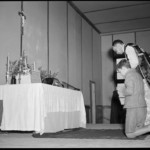
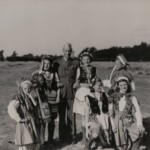

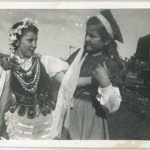
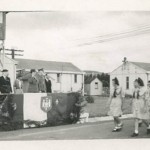
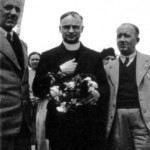
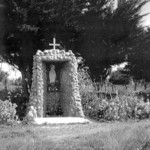
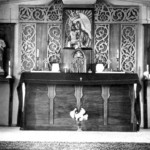
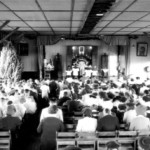
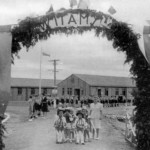
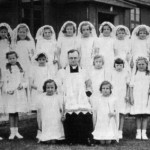
Documents

